Puget Sound Marine Area Bluffs: Human/Wildlife Conflicts
Human/wildlife conflicts can be classified as either destructive (damage to structures, habitat restoration projects, landscapes, crops, etc.), aggressive (probable harm to people or pets) or as health risks (potential transfer of disease/parasites to people and their pets).
The following deals primarily with destructive behavior (herbivory) by mammals that gardeners, landscapers, and habitat restorations commonly come in contact with. Table 1 is designed for quick reference; the information is intended as a general guide and further information can be found under “Resources.”
Note: From bats to woodpeckers, thirty wildlife species will soon be described on the Washington Department of Fish and Wildlife’s website (WDFW.wa.gov). The website will provide detailed information on how to prevent and solve conflicts with the wildlife that provoke the most calls to wildlife agencies and nonprofit groups. Look for new postings beginning in July of 2004.
Washington State Laws
State laws provide for the protection of virtually every resident wildlife species. Where state law duplicates federal law, state law standards are often more restrictive than their federal counterparts. Note: Local laws are sometimes more restrictive than state laws when trapping and other forms of wildlife control are involved.
State laws that are commonly referred to:
- RCW 77.08.010 Definition of Wildlife. (Including “Wildlife,” “Wild Animals,” “Protected Wildlife, “Endangered Species,” and “Deleterious Exotic Wildlife”)
- RCW 77.12.240 Authority to take wildlife. (Removal or killing of wildlife that is destroying or injuring property.)
- RCW 77.15.250 Unlawful release of wildlife. (Unlawful to trap an animal on your property and release it elsewhere.)
- RCW 77.36.030 Trapping or Killing Wildlife Causing Damage. (Emergency situations.)
See Revised Code of Washington (RCW) provisions at www.leg.wa.gov/rcw/index.cfm for complete definitions.
Barriers
Barriers include fencing, tree guards, and exclusion netting. Collectively, they represent some of the most effective and predictable indirect control measures available. Examples include:

Major materials include sturdy, rot-resistant wooden corner posts set in concrete (optional), wooden or studded steel T line posts, woven wire fencing, and gates.
If needed, extensions can be attached to the top of the fence to prevent deer from jumping over. A 2-foot high band of chicken wire can be added to the bottom to exclude rabbits and hares.
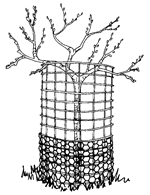
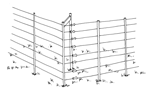
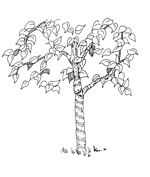
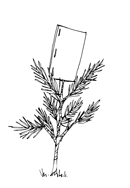

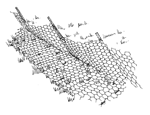
To prevent the mountain beaver from digging under the fence, keep a 2-foot wide wire apron on top of the ground on the mountain beaver’s side of the fence. Keep the apron flush to the ground with rocks and/or stakes, or the mountain beaver will shimmy under it. (Drawing by Jenifer Rees.)
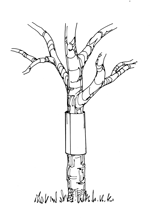
Frightening Devices
A wide variety of visual devices have been used for temporary control. Examples include: flags, mylar balloons, flashing lights, and traditional scarecrows. A new “Scarecrow®” detects the presence of an animal using infrared detection, and scares it away by spraying a high-pressure jet of water. While effective on birds, frightening devices are much less effective on mammals.
Repellents
Repellents use a disagreeable odor or taste, or a combination of both, to dissuade mammals from eating the treated plant. They are easy to apply and homemade solutions are inexpensive.
Numerous odor and taste repellents have been developed, and new products are continually becoming available. There have been numerous studies to test the effectiveness of these repellents, often producing conflicting results. No repellent eliminates damage entirely.
Habitat Changes
A commonly recommended form of control is to remove brush piles, weed patches, rock piles, and other debris where rabbits, hares, and other rodents live and hide. Before doing this, consider the potential impact on other desirable wildlife species.
Another form of control is to provide less palatable plant material for beavers, deer, rabbits, etc. See above note in introduction for information.
Natural Control
Many species of wildlife eat voles, rabbits, mountain beaver, etc., and having the animals in your area may give you the opportunity to see one of their predators. Encouraging these animals’ natural predators—or at least not interfering with them—also may aid in reducing the damage they cause. Although predators will not keep vole, rabbit and other populations below the levels that present problems in gardens and landscaped areas, natural control can be combined with other methods to help prevent severe losses. Recently there has been interest in attracting barn owls and other raptors to an area for rodent control using nest boxes and perch poles (Fig. 9).
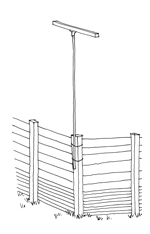
Trapping
If you cannot resolve a conflict with an animal by other means—such as removing attractants, installing barriers, applying repellents—a final alternative is to trap it. Trapping is the last option because it presents many problems for both the animals and the trapper. Also, it rarely is a permanent solution if other animals are in the area, and food and/or shelter remain available to them.
Appropriate times to trap an animal in or around a home or property include emergency situations, the removal of a targeted problem animal, or when trapping is the only practical solution.
On November 7, 2000, Washington state voters approved Initiative 713, which places limits on the use of body-gripping traps to take animals (see Initiative 713 Fact Sheet under Resources). The most commonly used traps, other than snap traps for Old World mice and rats, are now cage traps.
When used properly, cage traps can offer nonlethal solutions to conflicts. However, despite the perception that live capture in cage traps is humane, animals often experience stress and physical damage during the capture. Captured animals may also suffer from exposure to extreme weather and lack of water. Such injuries, trauma, and disorientation may lead to the death of an animal weeks after it has been released. (See RCW 77.15.250 Unlawful release of wildlife above for important information.)
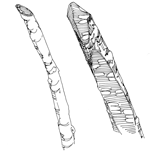
| Species | Sign | Control Techniques |
|---|---|---|
| Beaver | Webbed, 5 toed hind tracks; chisel-like gnawings on trees, clipped stems. | Barriers: Prevent or mitigate damage by placing metal mesh fence exclosures around small areas or individual plants. A fence placed between protected area and the water can discourage beaver. Also, a fine sand can be added to alkyd paints and applied to woody plants to deter gnawing on bark. Frightening Devices: Occasionally, bright lights can deter nocturnal damage to plants. Habitat Changes: Pond levelers have some benefit in some situations. Conduits can be placed through dam sites to allow water to pass through, keep water levels low and still maintain beaver colonies and some habitat. Plant Selection: Plant spruce, elderberry, cascara, osoberry (Indian plum), ninebark, and twinberry, because they are not the beavers’ preferred food plants. Plant aspen, cottonwood, willow, spirea, and red-twig dogwood because, once their roots are well established, the upper parts of the plants often resprout after being eaten. Note: Beavers do use plants as construction materials that they might not eat. Repellents: Two repellents that have had some success are Big Game Repellent® and Plantskydd®. Trap: Use a Hancock or Bailey suitcase-type trap. Professional services are recommended for trapping and installation of pond levelers. |
| Cottontail rabbit and hare | Clean-cut, angled clipping-off of flower heads, buds, and young stems up to inch in diameter. Evidence of gnawing can be found on the stems of woody plants, blackberry canes and other brambles, and fallen twigs and branches. | Barriers: 18-inch high chicken wire around individual plants or planted areas. A variety of commercially available protectors are effective. Frightening Devices: Occasionally, bright lights, pin wheels, mylar ballons, etc, can deter nocturnal damage to plants for a short time. Repellents: Commercial repellents must be applied often and (preferably) before high damage levels occur. Habitat Changes: Remove brush piles, weed patches, rock piles, and other debris. Trap: Single- or double-door type trap, 9 x 9 x 26 inches. Bait with fresh vegetables in summer; apples, carrots, or bread in winter. (See “Trapping.”) Lethal Control: Sport hunting can temporarily reduce general populations in rural areas. |
| Deer | Two-toed tracks, leave small branches and twigs with ripped edges. Trees, shrubs and garden crops are affected. | Barriers: High or electrified fences or individual barriers. Frightening Devices: Pyrotechnics and exploders. Repellents: Commercial or homemade products work temporarily and need to be reapplied in wet weather. None are 100% effective. Habitat Changes: Don’t plant along deer trails; use local deer resistant plants. |
| Mice | Gnaw marks knifeblade thin; in droppings; rub marks inside vertical corners; gnawings on stems, structures; newly planted seed; stored human and animal foods. | Barriers: Close all openings smaller than inch. Mice have the ability to jump 12 inches high and can run up any rough vertical surface. Frightening Devices: Sonic devices have not proven to be effective. Repellents: Ineffective. Habitat Changes: Sanitation through clean-up of grains, pet or human foods; storage of boxes of foods and potential nesting materials (cardboard, paper, cloth) in plastic containers with tight-fitting lids. Remove or mow weeds and vegetation. Restrict water access. Trap: Many types of snap traps and live traps (including multiple capture) are used. Chemical control: Anticoagulants, other toxicants in a bait station. |
| Moles | Erratic and extensive feeding ridges in turf with occasional, fist-sized conical mounds. Rarely do moles feed on bulbs and roots. Insect-foraging activity and tunnels may cause drying of roots. | Barriers: Metal perimeter barriers buried at least 4 inches may lower mole foraging activity; buried to 30 inches may temporarily eliminate mole travel. Frightening Devices: Vibrators or ground and sonic devices are unproven. Repellents: Castor oil-based repellents may be registered; home-remedies of chewing gum, broken glass, repelling plants, and others are unproven. Habitat Changes: Eliminate turf areas where moll hills are unsightly. Trap: When and where legal, Victor (harpoon), Nash (choker loop) and Out-of-Sight grip are most common. |
| Mountain beaver | Clipped twigs and branches and stripped bark on shrubs and trees. Seedlings less than 1.5 inches in diameter most often eaten. Most often a clean, slanted cut similar to those made by other rodents. | Barriers: Surround individual plants with 24-inch tall smooth metal cylinders to prevent climbing. A floppy fence can be used on a larger scale (see Figure). Frightening Devices: Lights may work for a short time. Repellents: Not proven consistently effective. Habitat Changes: Harass with old cat litter, rocks, or dirt in holes. Trap: Use single-door type, 7 x 7 x 17 in. live trap. Bait with apple, sweet potato, or whatever is being eaten in the area. Set trap directly in the entrance of an active tunnel. Mountain beavers are very prone to hypothermia, so wrap the trap with black plastic or burlap and cover it with soil. Trap when the weather is mild and check the trap early in the morning. (See “Trapping.”) |
| Opossum | Frequent garbage and compost sites, pet and wild bird feeding areas, and penned poultry or their eggs. | Barriers: See Raccoons. Frightening Devices: Lights may work for a short time. Repellents: Pepper spray or a commercial taste repellant may work temporarily. Habitat Changes: Clean up compost, garbage, and other food sources can help. Trap: Single- or double-door type, 11 x 11 x 36 inches. Bait with dry or canned pet food, sardines, old meat, chicken entrails, bacon, fish, apples. (See “Trapping.”) |
| Raccoon | Newly planted turf torn up; dead poultry and missing eggs; ponds that are disturbed; nervous fish. | Barriers: Install sheets of aluminum flashing, at least 3 feet square, around the corners of buildings to prevent climbing. Install baffles on trees and poles. Completely enclose poultry. Surround ponds with electric wire or completely cover. Frightening Devices: Lights, sprinklers, and noises will only work temporarily. Repellents: Pepper spray or a commercial taste repellants may work temporarily. Habitat Changes: Don’t feed raccoons. Trap: Live trap in single-door type trap, 10 x 12 x 42 inches. Bait with fish-flavored cat food, corn, ripe bananas, bacon, sardines, peanut butter, jelly marshmallows, (resemble eggs and have eye appeal). (See “Trapping.”) |
| Rats | Eat and contaminate stored grains, seeds, pet foods; gnaw wiring, structures; poultry; disease hazard. | Barriers: Place metal or heavy plastic barriers over pipes that rats climb to gain access into buildings. Cover plantings with wire mesh and secure edges. Frightening Devices: Rats quickly adapt to novel sounds. Repellents: Sonic devices have not been proven as long-term repellents. Dogs and cats are of limited value. Habitat Changes: Store human, animal, and other food in rat-proof buildings, rooms, or containers. Prevent access to fruit and compost. Eliminate access into buildings. Trap: Commercially available snap traps baited with peanut butter. |
| Squirrels | Gnaws bark, wiring and tubing; caches seeds, nuts and cones; nuisance at bird feeders. | Barriers: Baffles on trees and posts. Individual wire or other barriers over small plants. Frightening Devices: Squirrels quickly get use to novel sounds and objects. Repellents: Pepper spray or a commercial taste repellant. Habitat Changes: Eliminate access into buildings. Trap: Single- or double-door type, 6 x 6 x 24 inches; longer for double-door traps. Use peanut butter, nuts, corn, sunflower seed, popcorn, bread as bait. (See “Trapping.”) |
| Voles | 1 to 2-in wide runways in grasslands; gnawing damage on young trees and shrub bark. | Barriers: Cylinders made from wire mesh, plastic pipe, or other material and buried 4 to 6 inches; layers of tinfoil wrapped around stems above and below ground. Protecting large areas is cost prohibitive. Frightening Devices: Electromagnetic or ultrasonic devices and flooding are not effective. Repellents: Ineffective. Habitat Changes: Remove grassy cover by regularly mowing, grazing, or tilling along ditch banks, rights-of-way, or field edges adjacent to vulnerable areas. Encourage vole predators. Trap: Low numbers or densities of voles can be trapped using “mouse traps” baited with peanut butter and oatmeal mixture. |
Resources
Books
- Coleman, John S., S. Temple, and S. Craven. Cats and Wildlife: A Conservation Dilemma. (Available from: Publications Room 170, 630 W. Miffin Street, Madison, WI 53703; phone: 608-262-3346.)
- Conover, Michael. Resolving Human-Wildlife Conflicts: The Science of Wildlife Damage Management. Boca Raton, FL: Lewis Publishers, 2002.
- Hodge, G. R., ed. Wild Neighbors: The Humane Approach to Living with Wildlife. Golden, CO: Fulcrum Publishing; Washington, DC: Humane Society of the United States, 1997. (Available from: Urban Wildlife Resources, 5130 W. Running Brook Road, Columbia, MD 21044.)
- Hygnstrom, Scott E., et al. Prevention and Control of Wildlife Damage. Lincoln, NE: University of Nebraska-Lincoln, Institute of Agriculture and Natural Resources, 1994. (Available from: University of Nebraska Cooperative Extension, 202 Natural Resources Hall, Lincoln, NE 68583-0819; phone: 402-472-2188; also see Internet Sites below.)
- Juhre, Robert G. Preventing Deer Damage. 3rd edition. Kettle Falls, WA, 1998. (Available from: Robert G. Juhre, 1723 Mountain Garden Way, Kettle Falls, WA 99141-9771.)
- Lawrence, Fred A. Mole Control: A “How To” Handbook for Homeowners Who Want to Solve Their Own Mole Problems. The Washington State Trappers Association Inc., 1985.
- Link, Russell. Living with Wildlife in the Pacific Northwest. Seattle: University of Washington Press and the Washington Department of Fish and Wildlife, 2004.
- Smith, Arthur E., Scott R. Craven, and Paul D. Curtis. Managing Geese in Urban Environments. (For ordering information, see www.wildlifedamagecontrol.com)
Internet Resources
- Coexisting with Coyotes (From the Stanley Park Ecology Society):
www.vcn.bc.ca/spes/urbanwildlife/cocoyote.htm - Habitat Modification and Canada Geese: Techniques for mitigating human/goose conflict in urban and suburban environments:
www.canadageese.org/nlcontrol.html - Initiative 713 Fact Sheet:
wdfw.wa.gov/factshts/i-713.htm - Prevention and Control of Wildlife Damage:
wildlifedamage.unl.edu/handbook/handbook/ - The Internet Center for Wildlife Damage Management:
wildlifedamage.unl.edu/ - Vertebrate Management Links:
www.snohomish.wsu.edu/verturl.htm - Veterinarian’s Guide to Managing Poisoning by Anticoagulant Rodenticides:
www.liphatech.com/vetguide.html - Wildlife Control Supplies:
www.wildlifecontrolsupplies.com/ - Wildlife Solutions Online:
www.wildlifesolutionsonline.com/home.htm - 2000 Report of the American Veterinarian Medical Association Panel on Euthanasia:
www.avma.org/resources/euthanasia.pdf
Additional Internet Resources
- Deer Fencing:
- Benner’s Deer Fencing®: www.bennersgardens.com/bg/
- Fickle Hill Fence Company (deer fencing systems): ficklehillfence.com
- Cat Containment Systems:
- Other:
- Roll Guard, Inc. (Coyote Roller®): www.coyoteroller.com/Products/flash_demo.htm
- Scarecrow® (The motion-activated sprinkler by Contech): www.scatmat.com
- Tomahawk Live Traps: www.livetrap.com/
Agencies involved in Human/Wildlife Conflicts
- U.S. Department of Agriculture (Wildlife Services) The Wildlife Services program, part of the U.S. Department of Agriculture’s Animal and Plant Health Inspection Service (APHIS), helps alleviate wildlife damage to agricultural and natural resources.
Phone: (360) 753-9884
Web site: www.aphis.usda.gov/ws - U.S. Fish and Wildlife Service (USFWS Pacific Region)
Handles threatened and endangered species on a federal level (includes all migratory birds). This agency also handles issues where contaminants are involved. All questions concerning permits and possible Endangered Species Act or Migratory Bird Treaty Act violations should be addressed to the Law Enforcement Branch.
Phone: (360) 753-9440
Web site: www.fws.gov
Pacific Region office directory: offices.fws.gov/directory/ListOffices.cfm - Washington Department of Fish and Wildlife (WDFW)
WDFW is responsible for managing wildlife in the state of Washington. Wildlife/human issues and concerns are handled by WDFW through various levels of response alternatives. WDFW offers assistance with wildlife conflicts through information and education, self-help advice, and referrals to various special permit holders. WDFW staff actively assists with wildlife issues involving public safety and/or severe property damage, wildlife law violations, and situations involving state threatened and/or endangered wildlife.
Headquarters:
Natural Resources Building
1111 Washington Street SE
Olympia, WA 98501
Mailing address:
600 Capitol Way N
Olympia, WA, 98501-1091
Telephone: (360) 902-2200
Fax: (360) 902-2230
Web site: www.wa.gov/wdfw/
WDFW Regional Offices around Puget Sound:- North Central Washington - Region 2
1550 Alder Street NW
Ephrata, WA 98823-9699
Phone: (509) 754-4624 - North Puget Sound - Region 4
16018 Mill Creek Boulevard
Mill Creek, WA 98012-1296
Phone: (425) 775-1311 - Southwest Washington - Region 5
2108 Grand Boulevard
Vancouver, WA 98661
Phone: (360) 696-6211 - Coastal Washington - Region 6
48 Devonshire Road
Montesano, WA 98563
Phone: (360) 249-4628
- North Central Washington - Region 2
- Washington State University Cooperative Extension
Cooperative Extension Agents have a wide variety of forestry and wildlife information. For your local county office, look under “Government,” then county, in your phone directory. Publications are available from the WSU Web site, local county offices, or by mail.
Mailing address:
Cooperative Extension Publications Building
Bulletin Department
Washington State University
PO 645912
Pullman, WA 99164-5912
Phone: (800) 723-1763 and (509) 335-2857
Web site: ext.wsu.edu/
County offices: http://ext.wsu.edu/locations/ - Washington Department of Health
Has information on diseases of animals, bite consultations (wild animal bites, ticks/fleas etc.). They do not deal with animal pick-up (dead or alive). Rabies and animal control division performs laboratory analysis of suspected rabid and other possibly diseased animals. They do not handle bee concerns.
State hotline: (800) 525-0127
For your county office, look under “County Health” or “Health” in a local phone directory or check the Web site below.
Web site: www.doh.wa.gov/ - Local Health Department Web sites:
www.doh.wa.gov/LHJMap/LHJMap.htm